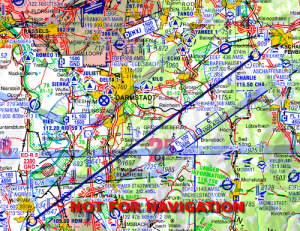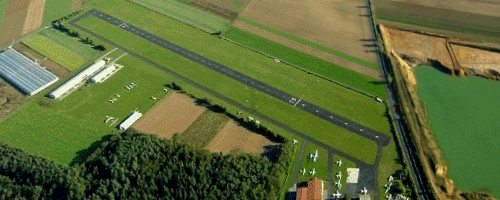It was my first cross country solo as a student pilot. Although I had soloed for the first time almost 7 months earlier, a long winter with poor weather had unfortunately not allowed a cross country solo until now, this beautiful morning in early May. I was heading to Aschaffenburg, 34 nautical miles northeast of my home field, Worms, and with a nice little Diamond DA20 Katana that translates to about 25 minutes enroute. Aschaffenburg is about 20 nautical miles south east of Frankfurt, and sits underneath Frankfurt’s class C airspace with a 3500 feet AMSL floor (roughly 2500 feet AGL). Frankfurt is a very busy airport, but Germany doesn’t use class B airspace anywhere and sticks to class C. If you’re familiar with US class B though, it has about the same feel to it, established two-way radio communication is not sufficient to enter, you’ll need an explicit clearance, although, in a VFR aircraft, you’re not very likely to get that clearance, at least not in Frankfurt.
The first leg went smooth, and with the help of the conveniently placed CHA VOR the confusing landscape below (a mess of open fields and forests) did not lure me off course. A bit of nervousness and some weird airflows caused by a sand quarry on short final made me come down somewhat fast though, and not wanting pull back too hard and enter an accelerated stall, I touched down a tad hard before the flare had arrested the descent and bounced slightly, but add a bit of power and the second touch down was smooth. Nothing major though, all in all it was an acceptable first cross country landing, I just needed a few minutes to calm my nerves and I was starting to feel pretty good about myself. I’m on top of this, what can go wrong?
When doing student solos in Germany, rather than having an endorsement in your logbook, you need a separate piece of paper with your instructor’s certificate number and contact information, along with the route you’re supposed to fly. You need to get this signed and stamped (Germans love stamps!) at each stop, as proof you were there, and it’s later added to your flight school’s records. So, after I had my paperwork signed and stamped, I was all set to return to Worms.
The departure went well, and I climbed in the pattern and leveled off at 3000 feet AMSL. I pulled the throttle and prop back to cruise, and settled in for the return trip. Then out of nowhere, I notice the altimeter starts to turn, I check the airspeed but it’s all trimmed out nicely for cruise, so I must’ve entered an updraft. With the class C above me I really did not want to climb, and from what I hear, you do not want to piss off the Frankfurt controllers. I pushed the stick forward to trade the altitude for speed, but the airspeed indicator soon reached the yellow arc, yet the aircraft kept climbing. Now what? I didn’t want to go faster as the thermals were quite bumpy. I started to reduce the power, which slows the ascent, but only so much and I’m soon at idle power, airspeed pegged at Vno and the altimeter still winding up. I was at a loss, nothing else occurred to me, and I kept thinking how ironic, all that meticulous preparation and I still bust the Charlie. After what felt like an eternity, although in reality it was just about a minute, the VSI finally drops below zero and the altimeter reads just over 3400 feet.
There are a couple of lessons to learn from this story.
First, the worst kind of problems aren’t the ones you’re merely unprepared for, they are the ones that never have crossed your mind. And even if they cross your mind, you’d dismiss them as being physically impossible. We can’t walk on water, we can’t pull ourselves up by our bootstraps, and we can’t sink through the concrete we’re just about to touch down on. Or can we?
Second, I could have, and probably should have, just kicked it over into a side slip and bled off the lift that way. I knew how to slip, but in mind it was filed under tricks when being high on final, not under tools for avoiding an imaginary ceiling above me, and for a student on his first cross country, it was too much of a leap. It didn’t occur to me until I was writing down my ‘diary’ entry of the flight. Which leads me to my final point, and really, perhaps unexpected, the moral of the story.
Third, keep a written account of your flights, at least during your time as a student pilot, or while working towards new ratings. Videotape it if you can. I would not be able to recall this flight in such vivid detail had I not sat down and written a diary of each and every flight I did as a student pilot as soon as I got home. It is great memory aid later in life, but more importantly, it also helped me analyze right then and there what I did well, and what I could’ve done better, as well as helped me actually understand (rather than merely hear) what my instructor had been telling me. If you don’t feel like writing a small essay after every flight (my student pilot diary is a 20 page monospaced 10-pt wall of text) then I would wholeheartedly recommend writing the most significant event(s) of the flight in the comment column of your logbook. It’ll make you think back on the flight while writing the entry, and it’ll help you remember at least some of it, perhaps even years from now.



Nice article, and very important lessons to remember.